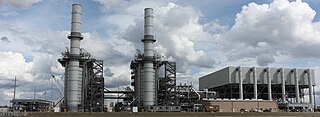
Electricity generation is the process of generating electric power from sources of primary energy. For utilities in the electric power industry, it is the stage prior to its delivery to end users or its storage.

Geothermal energy is the thermal energy generated and stored in the Earth. Thermal energy is the energy that determines the temperature of matter. The geothermal energy of the Earth's crust originates from the original formation of the planet and from radioactive decay of materials. The adjective geothermal originates from the Greek roots γῆ, meaning Earth, and θερμός, meaning hot.

A power station, also referred to as a power plant and sometimes generating station or generating plant, is an industrial facility for the generation of electric power. Power stations are generally connected to an electrical grid.

Beowawe is a small town, in Eureka County, Nevada, United States.
Electric power systems consist of generation plants of different energy sources, transmission networks, and distribution lines. Each of these components can have environmental impacts at multiple stages of their development and use including in their construction, during the generation of electricity, and in their decommissioning and disposal. We can split these impacts into operational impacts and construction impacts. This page looks exclusively at the operational environmental impact of electricity generation. The page is organized by energy source and includes impacts such as water usage, emissions, local pollution, and wildlife displacement.

A thermal power station is a power station in which heat energy is converted to electricity. Typically, water is heated into steam, which is used to drive an electrical generator. After it passes through the turbine the steam is condensed in a steam condenser and recycled to where it was heated. This is known as a Rankine cycle. The greatest variation in the design of thermal power stations is due to the different heat sources: fossil fuel, nuclear energy, solar energy, biofuels, and waste incineration are all used. Certain thermal power stations are also designed to produce heat for industrial purposes, for district heating, or desalination of water, in addition to generating electrical power.

The Mayacamas Mountains are located in northwestern California in the United States. The mountain range is part of the Northern Inner Coast Ranges, of the California Coast Ranges System.

Geothermal energy in the United States was first used for electric power production in 1960. The Geysers in Sonoma and Lake counties, California was developed into what is now the largest geothermal steam electrical plant in the world, at 1,517 megawatts. Other geothermal steam fields are known in the western United States and Alaska. Geothermally generated electric power can be dispatchable to follow the demands of changing loads. Environmental impact of this energy source includes hydrogen sulfide emissions, corrosive or saline chemicals discharged in waste water, possible seismic effects from water injection into rock formations, waste heat and noise.

The Geysers is the world's largest geothermal field, containing a complex of 18 geothermal power plants, drawing steam from more than 350 wells, located in the Mayacamas Mountains approximately 72 miles (116 km) north of San Francisco, California.

Geothermal power is power generated by geothermal energy. Technologies in use include dry steam power stations, flash steam power stations and binary cycle power stations. Geothermal electricity generation is currently used in 26 countries, while geothermal heating is in use in 70 countries.
Energy technology is an interdisciplinary engineering science having to do with the efficient, safe, environmentally friendly, and economical extraction, conversion, transportation, storage, and use of energy, targeted towards yielding high efficiency whilst skirting side effects on humans, nature, and the environment.

Glenbrook was a resort in Lake County, California. It was located 10 miles (16 km) south-southeast of Kelseyville, at an elevation of 2293 feet.
AltaRock Energy Inc. is headquartered in Seattle, Washington and has a technology development office in Sausalito, California. It is a privately held corporation that focuses on the development of geothermal energy resources and Enhanced Geothermal Systems (EGS). AltaRock has filed patent applications and holds exclusive licenses for related intellectual property related to EGS. In 2008, it started its first project near The Geysers to demonstrate the ability of EGS to be a reliable, renewable and clean source for the production of electric power.

The Olkaria Area is a region located immediately to the south of Lake Naivasha in the Great Rift Valley of Kenya, Africa. It is geothermally active and is being used to generate clean electric power. The region has an estimated potential of 2,000 MW. This is almost double the maximum daily electricity peak demand recorded in 2008/2009 for the entire country.
The Russell City Energy Center (RCEC) is a 619-megawatt natural gas-fired power station, which began operating in August 2013. It is operated by Calpine, and is located in Hayward, California. It is named for Russell City and is built on that community's former landfill site.

Gateway Generating Station (GGS), formerly Contra Costa Unit 8 Power Project, is a combined-cycle natural gas-fired power station in Contra Costa County, California, which provides power to half a million customers in northern and central California. Gateway Generating Station is on the southern shore of the San Joaquin River, in Antioch, and is one of more than ten fossil-fuel power plants in Contra Costa County.

Kelsey Creek is a watercourse in Lake County, California, United States, that feeds Clear Lake from the south. The watershed was forest-covered. In the lower parts it has been converted to farmland and for urban use. Higher up the forests have been cleared, regrown and cleared again. The northern part of the creek flows through a geothermal field that feeds power plants and hot springs. The wooded Cobb area in the higher part of the watershed holds resorts and resort communities, some dating to the 1850s.












